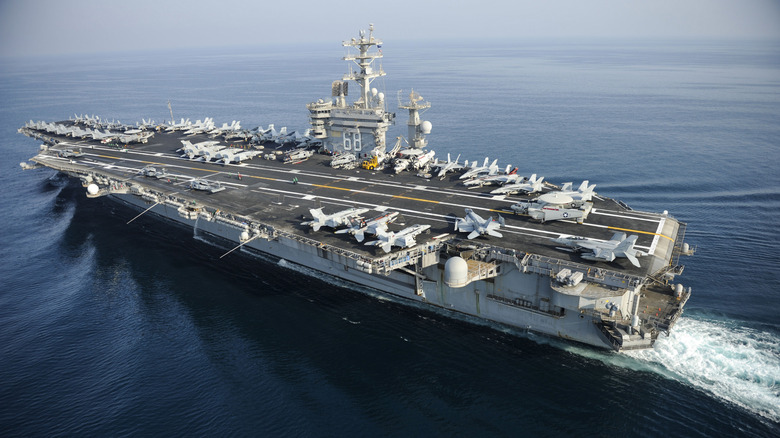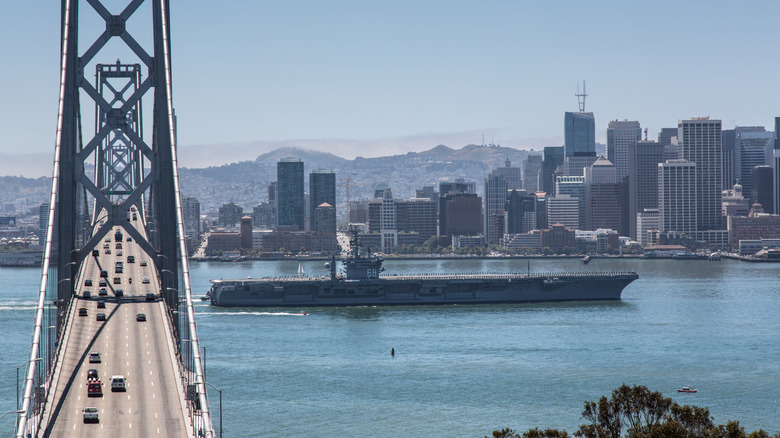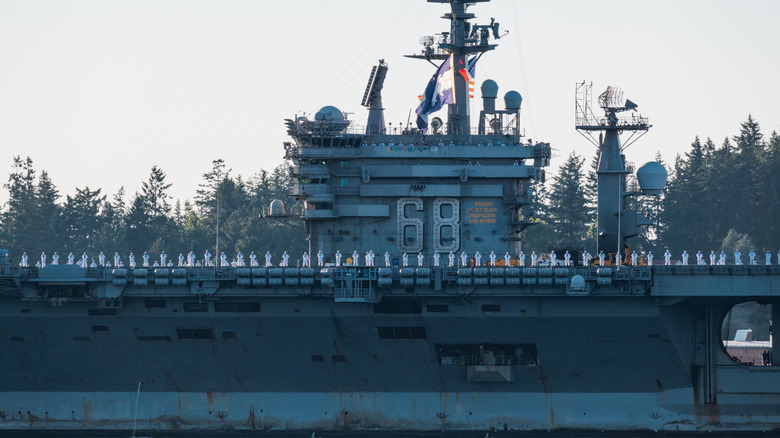Why The Nuclear Powered USS Nimitz Carrier's Retirement Is So Important
On March 21, 2025, the aircraft carrier USS Nimitz departed Naval Base Kitsap-Bremerton off the coast of Washington state for its 22nd and final deployment. Throughout the year, it made its way to Hawaii, Guam, Malaysia, the United Arab Emirates, and other locations. Its missions have primarily involved replenishment-at-sea operations, meaning it has assisted other ships at sea.
The USS Nimitz has a long and impressive history. Construction began in 1968 at the Newport News Shipbuilding and Dry Dock Company in Virginia. It was officially launched in 1972, meaning its impending retirement constitutes a robust 53-year career. Nimitz was the first of her class, capable of accommodating over 5,000 crew members and reaching speeds of 30 knots or more, equivalent to 34.5 miles per hour.
The retirement of the USS Nimitz is significant not only because of its long and distinguished career but also due to its innovative contributions. It was an early aircraft carrier designed to operate with nuclear power, enabling it to stay at sea for extended periods and travel farther than conventional carriers. Powered by two A4W nuclear reactors with four steam turbines and four shafts, the ship pioneered advanced nuclear propulsion at sea. It will make its way south from the Strait of Hormuz as it completes its final tour.
The USS Nimitz carrier's history
The 1970s through the 1990s were a busy time for the USS Nimitz. It participated in multiple critical NATO exercises around the world and was on standby to assist with evacuations of Americans out of Lebanon during its civil war in the 1970s. It supported the U.S. Navy with an American hostage situation in Iran. It was stationed in the waters off of Libya during a North African international war crisis. It also supported the operations Desert Storm and Desert Sabre.
By the turn of the century, the USS Nimitz had participated in significant missions, as well as training exercises, support assignments, and replenishment-at-sea operations. In 2014, it was part of the Navy's first F-35C Lightning II landing, improving stealth operations for the military. In 2021, it completed a 314-day deployment, breaking records in the U.S. 3rd, 5th, and 7th Fleet Areas of Responsibility. It even saw action in June of 2025, supporting combat during the Iran–Israel 12-Day War.
During its final voyage, the USS Nimitz has still been making history. Its visit to Bahrain marked the first time a U.S. aircraft carrier had visited the country in five years. This was critical in strengthening relationships between Bahrain and the U.S, but as much as the Nimitz has contributed to the United States' diplomatic and military policies, its final retirement date is scheduled for May 2026, when it will be decommissioned.
Transitioning naval power for the future
As nuclear technology continues to attract the attention of Big Tech and generate international interest, it cannot be understated how vessels like the USS Nimitz paved the way for where we are now and where we are going in the future. Its successor will be the USS John F. Kennedy. The John F. Kennedy has faced setbacks to its delivery date, but hopefully it will be ready to go and take up the Nimitz's mantle soon. Between the time when the Nimitz is decommissioned and the USS John F. Kennedy is ready, the Navy's carrier fleet will be temporarily down by one ship.
The Nimitz's decommissioning also raises the question of the future usefulness of Navy aircraft carriers. The relative simplicity and low cost of attack drones seem to be dominating the new age of warfare, prompting the development of anti-drone and anti-aerial defense measures in response. While there may always be a need for aircraft carriers, technology is driving the future of war. Drones are much smaller and less expensive than planes and do not require a pilot onboard. Giant carriers like the Nimitz may no longer be needed to serve the purpose they once did.
The USS Nimitz will return to Newport News shipyard in Virginia, where it was first built, for decommissioning. However, its legacy will endure, and its trailblazing operations, design, and support have left a lasting impact on U.S. military operations and nuclear technology today.


